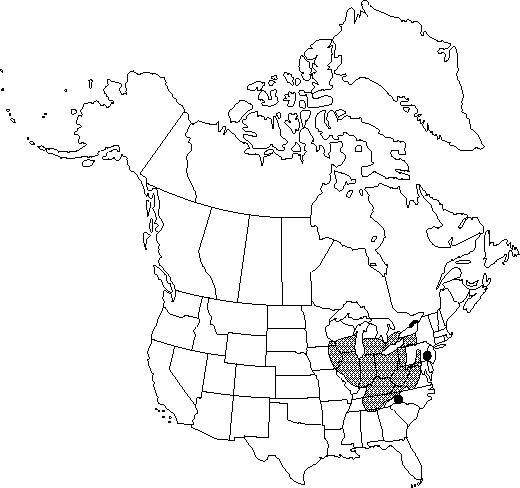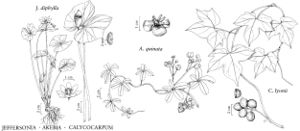Jeffersonia diphylla
Syn. Pl. 1: 418. 1805.
Leaves: petiole slender, erect, 9-25 cm at anthesis, maturing to 18-43 cm. Leaf blade 2-foliolate, often with minute apiculation between leaflets; leaflets 1.2-4 × 0.6-2.5 cm at anthesis, maturing to 6-13 × 3-7 cm, lobes rounded to acute. Scapes 9-33 cm, frequently taller than petioles at anthesis. Flowers: sepals elliptic to obovate, 7-15 × 4-6 mm; petals white, elliptic to obovate, 11-22 × 9-12 mm; stamens 6-12 mm; filaments 2-3 mm; anthers 4-9 × 1-1.5 mm; ovaries 6-11 × 3-7 mm. Fruits 18-38 × 8-17 mm, leathery, opening transversely, apical quarter resembling lid, becoming reflexed. Seeds oblong, 4-7 × 2 mm; aril laciniate, attached at adaxial side of hilum. 2n = 12.
Phenology: Flowering early spring; fruiting spring.
Habitat: Rich moist woods to semiopen rocky slopes and outcrops, usually over limestone or other calcareous rocks
Elevation: 100-800 m
Distribution

Ont., Ala., Ga., Ill., Ind., Iowa, Ky., Md., Mich., Minn., N.Y., N.C., Ohio, Pa., Tenn., Va., W.Va., Wis.
Discussion
Plants of Jeffersonia diphylla were used medicinally by Native Americans for treatment of dropsy, gravel and urinary ailments, and for gall and diarrhea, and in poultices for sores and ulcers (D. E. Moermann 1986).
Selected References
None.
